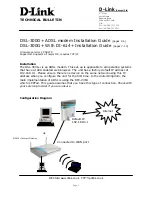
SPECIFICATIONS:
Hardware Required: Cards can be installed only in MicroRacks (RM202, RM204, RM208 and RM216)
Cable Required: For modem-to-modem line: Two- or four-wire unconditioned twisted-pair, 19 to 26 AWG
Interfaces: Serial: EIA/TIA-561 (compatible with EIA RS-232 and ITU-TSS [CCITT] V.24);
Line: Two- or four-wire telco;
Internal: Card-edge for module--MicroRack interconnection.
Protocol: Asynchronous or Synchronous.
Clock Source: Internal, external (from DTE) or received (from other Card) (user-selectable).
Data Format: Word length (including start bit, data bits, stop bits, and parity bit) must equal 8, 9, 10, or 11 bits. (user-selectable)
Flow Control: Transparent to all types of software (X-ON/X-OFF, robust X-ON/X-OFF, etc.) flow control; can be set to support hardware flow
control.
Operating Mode: 2-wire half-duplex or 4-wire half- or full-duplex. (user-selectable).
Data Rates: 57.6, 38.4, 28.8, 19.2, 14.4, 9.6, 7.2, 4.8, 3.6, 2.4, or 1.2 Kbps (user-selectable)
Maximum Distance: See chart.
Isolation: 1500 volts RMS minimum using customer transformers.
Surge Protection: Silicon Avalanche Diodes.
Surge-Response Time: 1 ps.
Maximum Surge Protection: 600 watts dissipated after 1 ms.
User Controls: (2) Front-panel toggle switches: Remote or (local) Analog loopback; 511 or 511/E V.52 diagnostics;
(3) 8-Position DIP switches on main module:
(1) for data rate, clock source, protocol, and carrier control;
(1) for 2- or 4-wire operation, diagnostics, RTS/CTS delay, signaling-rate range, and word length;
(1) for input impedance, point-to-point or multipoint operation, remote loopback-test initiation, and anti-stream control.
(3) Frame-ground-connection jumpers on interface module: To Line Shield, DTE Shield (Protective Ground), and Signal Ground
Indicators: (11) Front-panel LED's:
(1) each for Power, Test, Error;
(2) each for TD, RD, RTS, AND CD.
Diagnostics: ITU-TSS V.54 remote digital and local analog loopbacks; ITU-TSS V.52 BERT testing.
Connectors: On Main Board: (1) 50-position card-edge male (to MicroRack);
On Interface Module: (1) 50-position card-edge male (to MicroRack); (1) 6-pin RJ-11 female for modem-to-modem line,
(1) 10-Pin RJ female for modem-to-DTE line.
Power: From MicroRack's power supply.
Input: 120 VAC or 240 VAC (user-selectable);
Output: 10 VAC.
Consumption: 1.8 watts typical
Fuse: On MicroRack:
400 ma when power supply is set to 120-VAC input;
200 ma when power supply is set to 240-VAC input.
INTRODUCTION:
The Multi-Function LD Card is a short-range modem on a dual rack card (it has a main [front] module and an
interface [rear] module). The Card operates across two wires (half-duplex) or four wires (full- or half-duplex),
communicating synchronously or asynchronously, up to a maximum range of 20 miles (32.2 km). You can set
the Card to any of twelve data rates from 1.2 to 57.6 Kbps. Local and remote modems on Multi-Function LD
Cards always communicate with each other synchronously. When connected to an asynchronous RS-232
device, the Card performs synchronous--asynchronous conversion.
The Card has several features that enhance its overall performance, including automatic equalization,
automatic gain control, and anti-streaming timer, transformer isolation, and Silicon avalanche Diode surge
protection. The Card also has strong diagnostics: It features V.52-compliant bit-error-rate (BERT) pattern tests
and two V.54 test modes. with the Card's 11 easy-to-read front-panel LED's you can easily monitor the status
of data transmission and diagnostic testing.
The Multi-Function LD Card is fabricated using the latest surface-mount technology, so you get high-quality
short-range modem performance on a convenient rack card. The Card is available with a 10-Pin RJ connector
and RJ-11 line-interface connectors, on its interface (rear) module. It fills one function-card slot in our
MicroRacks (RM202, RM204, RM208, or RM216).
CONFIGURATION:
Setting the Switches on the Main Module:
The Multi-Function LD Card has three 8-position DIP switches -- S1, S2, and S3 mounted on the circuit board
of its main (front) module, as shown on the first page. These configuration switches allow you to select data
rates, clocking methods, V.52 and V.54 tests, word lengths, extended signaling rates, sync or async protocol,
2- or 4-wire operation, anti-stream control, and input impedance.
Configuration Switch "S1":
Use the individual positions on DIP switch S1 to set data rate, clock source, sync vs. async
protocol and carrier-control method. The factory-default settings are summarized in the Table below.
Position
Function
Default Settings
S1-1
S1-2
S1-3
S1-4
DATA RATE
DATA RATE
DATA RATE
DATA RATE
On
9600
Off
9600
Off
9600
On
9600
S1-5
S1-6
CLOCK SOURCE
CLOCK SOURCE
On
Internal
On
Internal
S1-7
PROTOCOL
On Asynchronous
S1-8
CARRIER CONTROL
Off
Constantly
ON



























